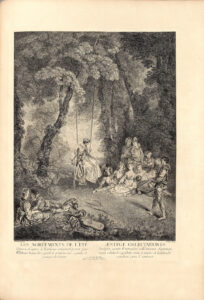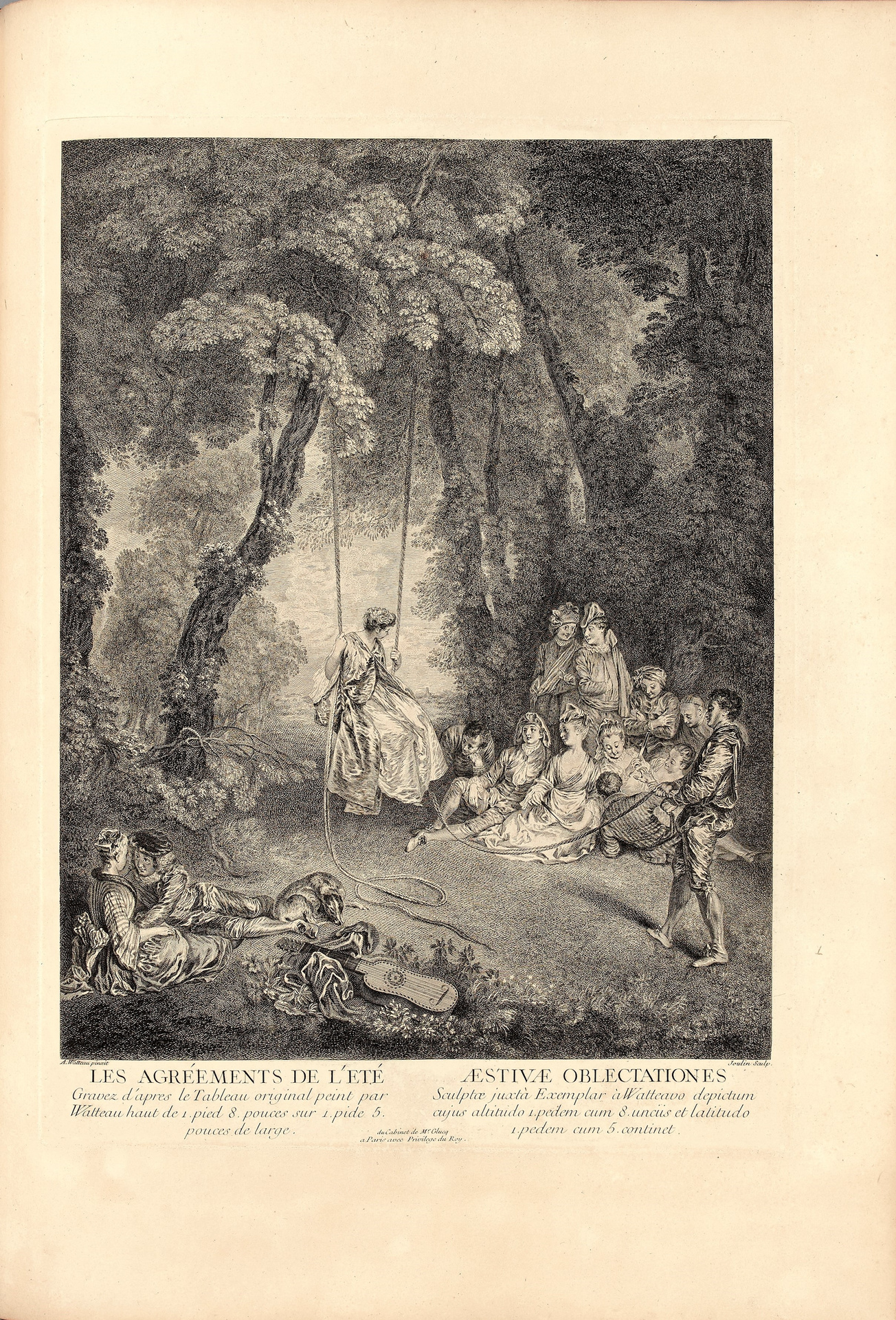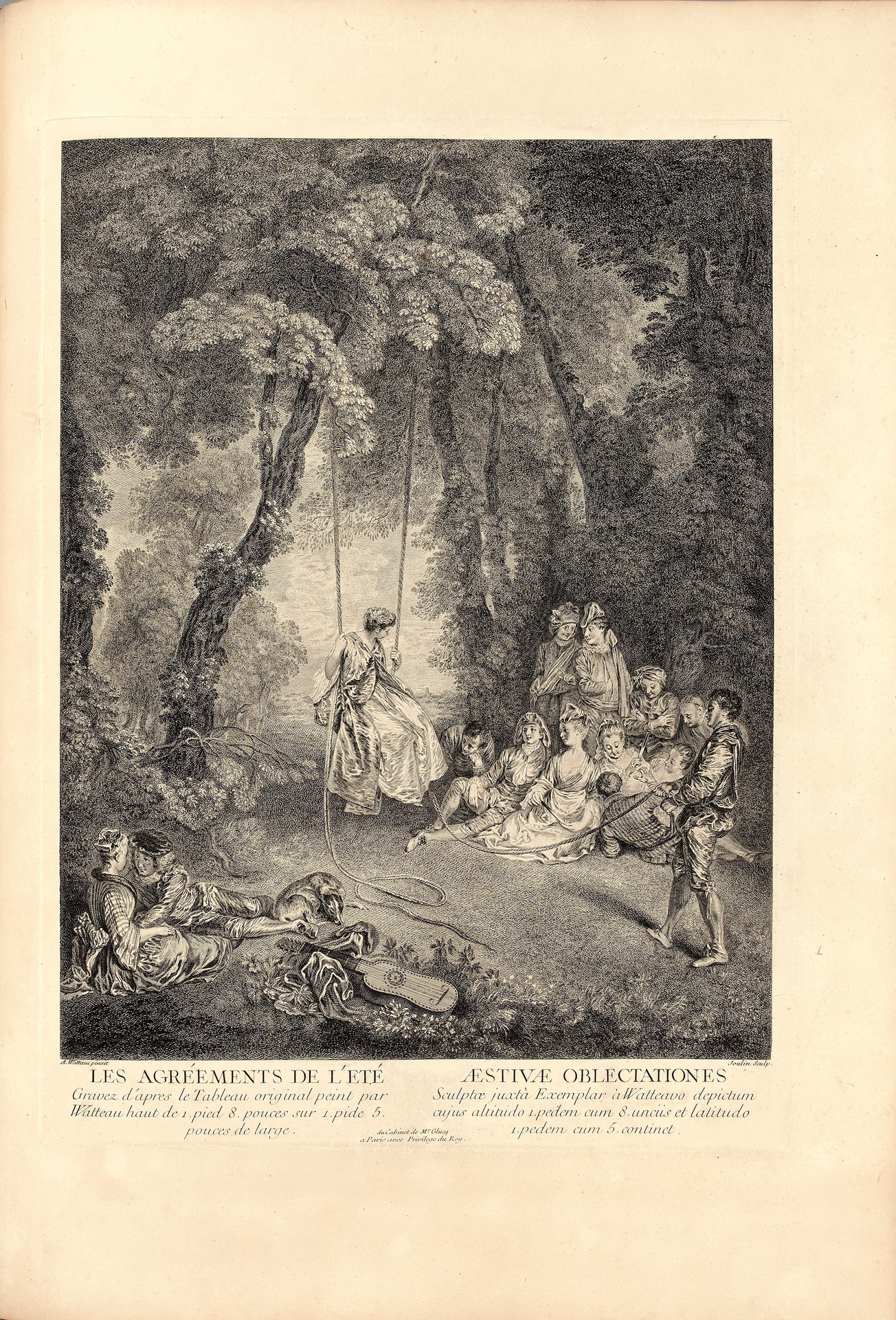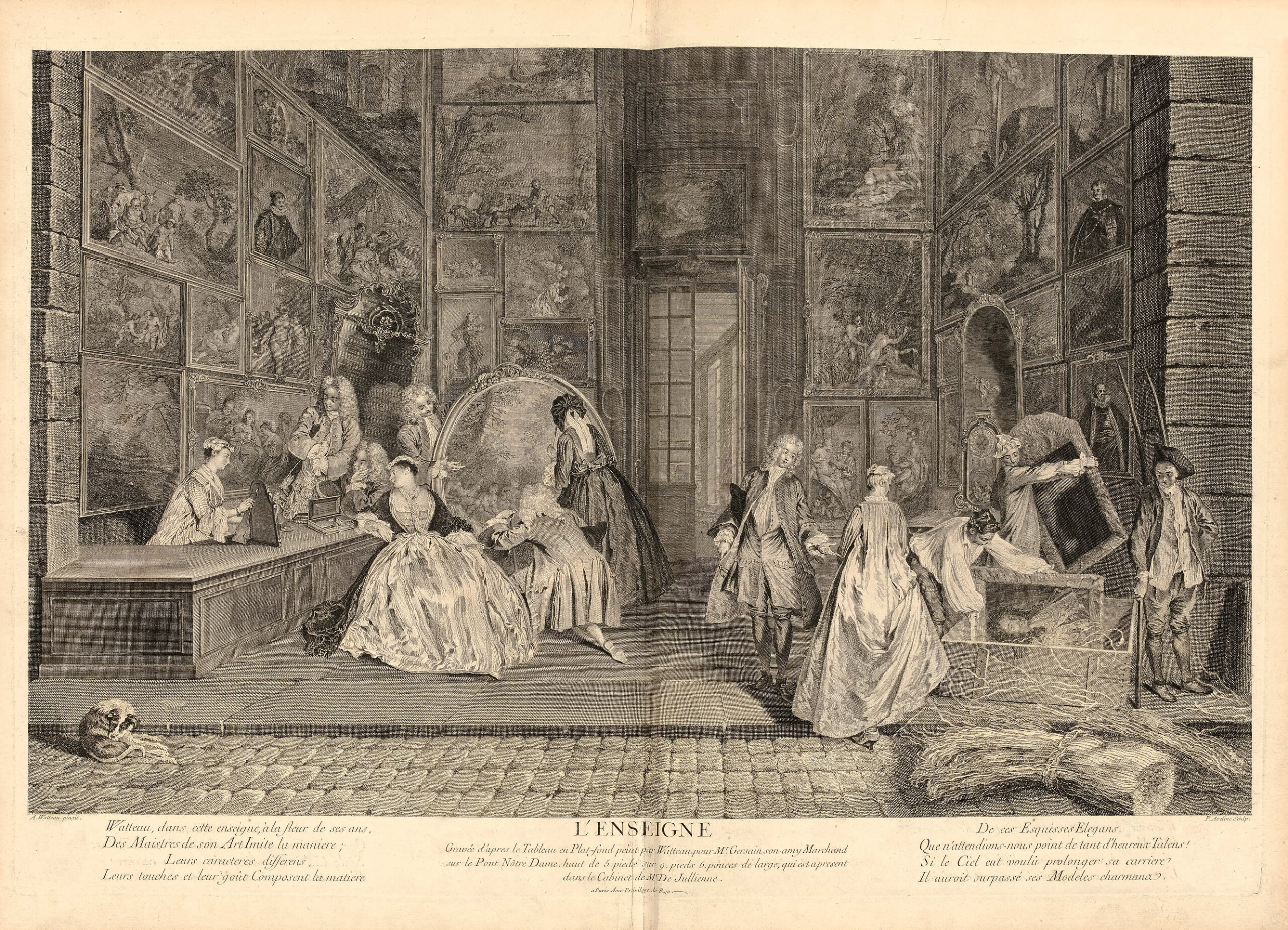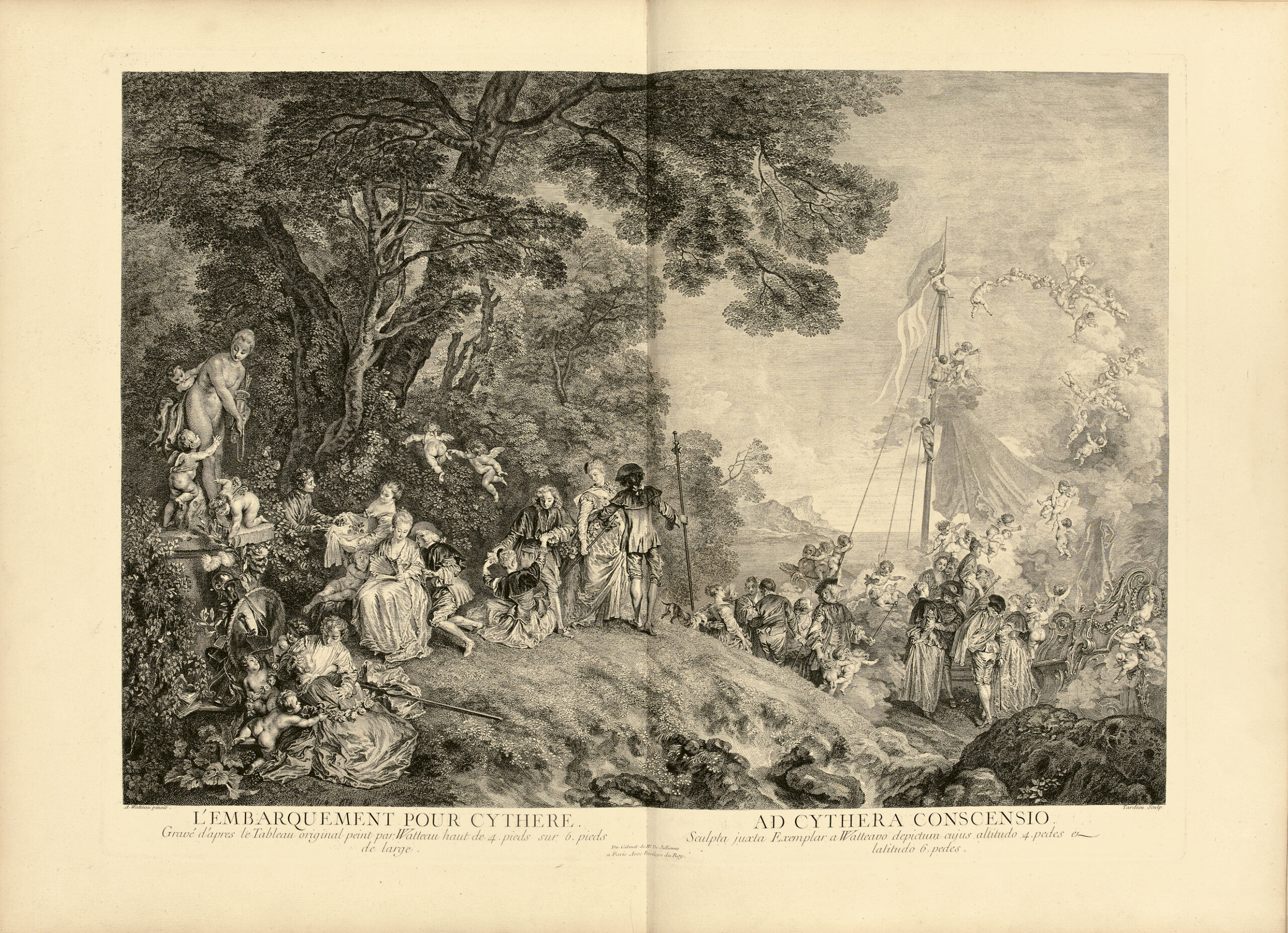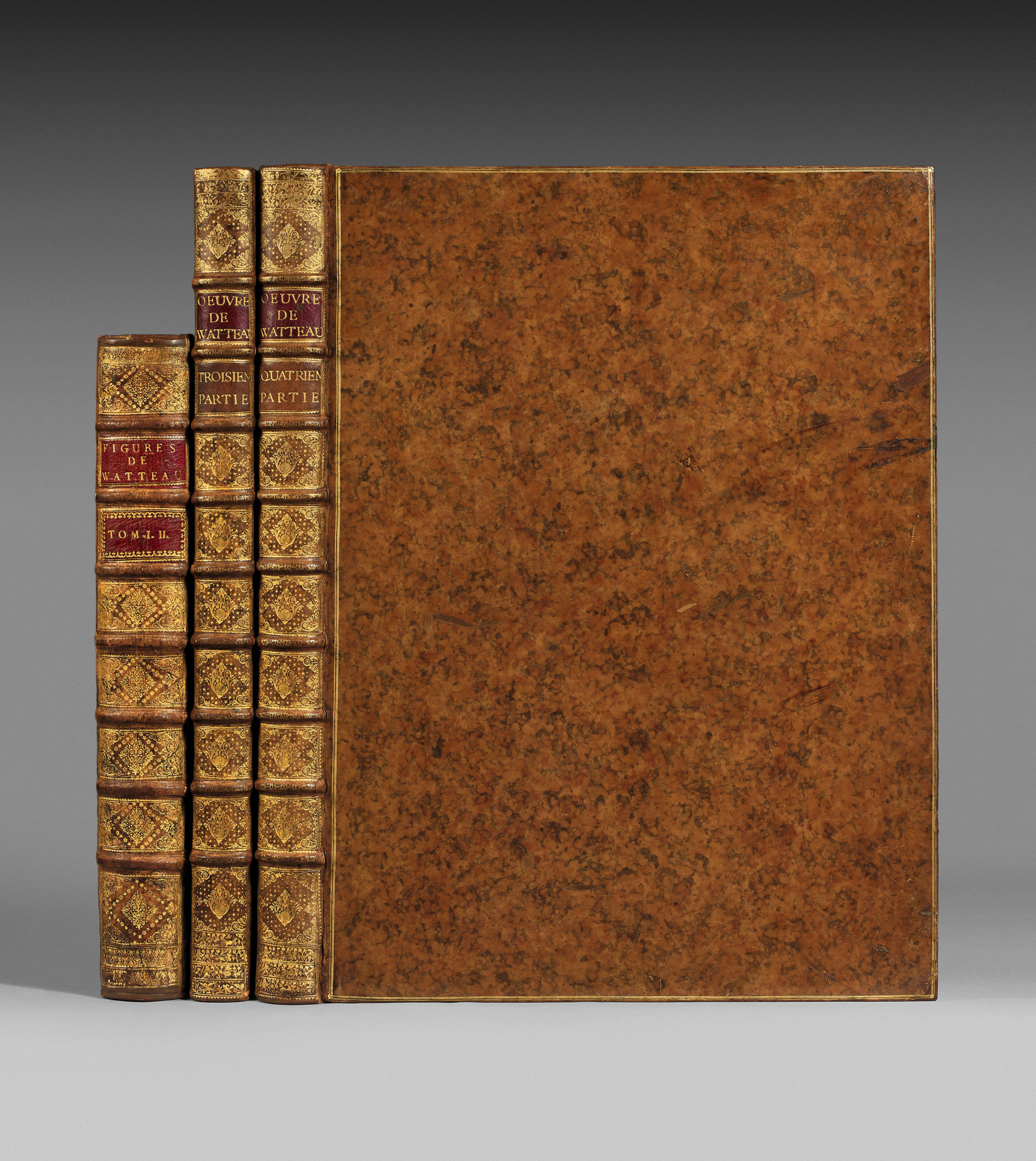A Paris, Fixé à cent exemplaires de pres épreuves. Imprimez sur grand papier.
2 large folio volumes [637 x 468 mm], circa 1735.
261 engraved plates.
– Vol. 1 : 1 engraved title, 1 leaf of engraved text, 1 engraved frontispiece, 38 plates; Figures de mode, dessinées et gravées à l’eau forte par Vatteau (sic). Paris : Duchange et Jeaurat, n.d.: 1 engraved title, 11 plates;
Figures Françaises et comiques, nouvellement inventées par M. Watteau. Paris, Duchange et Jeaurat, n.d. : 1 engraved title, 7 plates.
Autres vues. Paris Duchange, Gautrot et Joullain, n.d : 52 plates including 8 double.
– Vol. II: Œuvres des estampes gravées, d’après les tableaux et dessins de feu Antoine Watteau. Quatrième et dernière partie. Paris, Gersaint, n.d. : 1 engraved title and 153 plates.
A total of 261 engravings.
Binding in marbled calf, triple gilt fillet around the covers, spines ribbed and decorated, red and citron morocco lettering pieces. Contemporary binding.
Provenances: Comte Henry Greffulhe (1848-1932) (engraved ex-libris with his arms); André Langlois (ex-libris).
First edition.
“This sumptuous collection in two volumes is one of the most beautiful and rare books of the 18th century. Among the 100 copies that were printed, barely thirty still exist today (in 1910, 109 years ago) the others having been broken by the engravings’ merchants.” (Cohen).
It is to be observed that the Part I only contains pieces to look in height and the Part II pieces to look in length. When there are two pieces on the same plate, in Part I, they are therefore pieces in length in Part II, pieces in height.
– [With] : WATTEAU, Antoine. Figures de différents caractères de Paysages & d’Etudes dessinées d’après nature, par Antoine Watteau. Peintre du Roy en son Académie Royale de peinture et Sculpture, Gravées à l’Eau-forte par des plus habiles Peintres et Graveurs du temps, tirées des plus beaux cabinets de Paris.
A Paris, chez Audran, graveur du Roy en son Hôtel royal des Goblins et chez F. Chereau, graveur du Roy, rue Saint-Jacques, aux deux pilliers d’or, Roland scrips. F. Baillieul l’aisné sculpsit, n.d. (circa 1735).
2 volumes bound in 1 large folio volume [509 x 337 mm].
Volume I: (7) engraved ll. (title, portrait of Watteau by himself engraved by Boucher, Vie, 2 ll.; epitaph, 2 ll., preface 1 l. and 132 subjects on 101 plates.
Volume II: (3) ll. (title, notice, frontispiece by Boucher) and 120 (or sometimes 121) ll. containing the subjects 133 to 350.
Bound in marbled calf, with the arms of Samuel Bernard (OHR, 1043), triple gilt fillet around the covers, spine ribbed, red morocco lettering pieces, red edges.
Provenance: Samuel Bernard, comte Coubert (1651-1739). Contemporary binding with arms.
First edition of this precious collection published by the orders of Mr. de Julienne who, according to Mariette, engraved himself the n°221 and 222. The engravers of the other plates are Jean and Benoît Audran, Boucher, Cars, Caylus, Cochin, Desplaces, Lépicié, Sylvestre and Carle Vanloo.
This edition, the only good one is extremely rare.
In cased boards, untrimmed, 1 500 Gold fr., catalogue Fontaine 1874, n°2493.
In ancient calf, 2 500 Gold fr. Bulletin Morgand (1891), n°20348.
In half-binding by Pagnant 3 000 Gold fr., Bulletin Morgand (1899), n°35457; in sheets, 3 500 Gold fr. ibid. n°36821.
That is from 18 000 to 23 000 Gold fr. for the two works in 1912 according to Cohen thus 30 times the value of the great edition of La Fontaine’s Fables illustrated by Oudry in 4 folio volumes, Paris 1755-1759 of which a beautiful copy in first issue in morocco sells today for 30 000 €.
The work of Watteau is the rarest of 18th century collections of engravings.
It was compiled by the care of Jean de Jullienne, friend and protector of Watteau, and printed at his place, at the manufacture of the Gobelins, in one hundred copies.
We briefly summarize, from the precious research of Mr. Dacier and Mr. Vuaflart (Jean de Jullienne et les graveurs de Watteau), the history of this magnificent undertaking.
The engraving work began in 1717, four years before the death of Antoine Watteau, and continued until 1735.
For these engravings, Mr. de Julienne called the best artists of the time: Jean Audran, Desplaces, Dupuy, Cochin père, Edme Jeaurat, Benoît Audran, son of Jean, Siivestre, Laurent Cars, Bernard Lépicié, Carle Vanloo, Trémolières, François Boucher, then nineteen years old, Jean de Jullienne himself, his friend the comte de Caylus and an anonymous who signs M and could be M. de Montullé, Jullienne’s first cousin, Tardieu, Maurice Baquoy, Louis Crépy, Nicolas de Larmessin, Thomassin, Jean Moyreau, Gabriel Huquier, specialist of the arabesques, Bernard Baron, François Joullain, the brothers Liotard, de Genève, Aveline, François Chédel, Jacques Ph. Le Bas, Marie-Jeanne Renard du Bos, Louis Jacob, Etienne Fessard, a total of thirty-six artists.
Watteau himself engraved ten pieces that were retouched by the professional engravers.
Precious copy of one of the most beautiful books illustrated by a painter in the 18th century.
Copies complete with all their plates, such as this one, are extremely rare: from the first printing in 100 copies in 1735, a very small number escaped the engravings’ dealers who often preferred to sell the engravings apart. (Cohen-de Ricci, col. 1053-1065).
